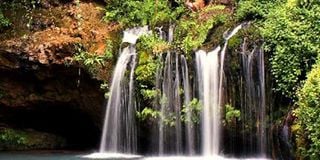Following the flow of the ‘Blue Pools’

The Blue Pool at Ngare Ndare Forest. PHOTO | ANDREAS FOX
What you need to know:
- This pioneering project allows elephants and various other animals to safely pass under the main Nanyuki-Meru Road and past various farms and communities, opening Mt Kenya to Lewa and conservancies beyond.
- The communities are permitted to use the forest to sustainably graze and water their domestic stock, but they also run various eco-tourism activities. Aside from the “blue pools”, there are waterfalls, forest hikes, camping grounds, and the only canopy-walkway in East Africa.
- You cannot simply turn up, as you need to book well in advance. This means rangers are assigned, and the use of each attraction, such as the “blue pools”, is organised to give each group its chance of experiencing the forest as we did – intimately.
I am sure everyone reading this will agree that Kenya is blessed with some phenomenally beautiful places. But do we all know the variety that is on offer? Do we all appreciate it?
While in South Africa, I was made aware of what they call the “Table Mountain Syndrome”. Ever present above the Cape Town sprawl stands the flat-topped wonder, biodiversity hotspot and major tourism draw – the Table Mountain. However, few local “Capetonians” have actually been up the mountain.
These days, especially in the social media, there are many more adverts for local tourism – particularly when coming up to holidays such as Mashujaa Day. Well, let me also offer something.
In the past months, I have twice visited what I am close to considering one of my favourite spots in the country. I had heard from friends about a magical place, known only as the “Blue Pools”. I finally got to visit them in August when staying on the Lewa Wildlife Conservancy, which so happens to be connected to the forest where these blue waters flow.
Ground water from Mount Kenya seeps through and emerges at the “source pool” with a striking turquoise tint. In the dry seasons, this is the only water flowing into the pools, making for the idyllic setting pictured. We spent hours picnicking and swimming in what felt like our private paradise.
REMNANTS OF MAJESTY
The Ngare Ndare Forest reserve encompasses a 5,550 hectares remnant of a previously vast indigenous forest that has survived logging and the expansion of farms and communities around Timau, Meru. Under supervision of the Kenya Forest Service, it is managed by the Ngare Ndare Forest Trust, a collaboration of six surrounding communities, and four farms and conservancies.
The forest, an important water tower, was incorporated into the Mount Kenya World Heritage Site in 2013, after it was reconnected to the mountain forests in 2011 via the “elephant underpass”, commissioned by the Mount Kenya Trust in partnership with the Lewa, Borana, KFS and KWS.
This pioneering project allows elephants and various other animals to safely pass under the main Nanyuki-Meru Road and past various farms and communities, opening Mt Kenya to Lewa and conservancies beyond.
This ensures greater genetic diversity, reduced human-wildlife conflict, natural migratory and browsing patterns. The forest is therefore open to all of the “Big Five”, and there is always a chance of an encounter when you visit. There are signs of elephants and buffalos everywhere, not to mention the prolific birdlife.
The communities are permitted to use the forest to sustainably graze and water their domestic stock, but they also run various eco-tourism activities. Aside from the “blue pools”, there are waterfalls, forest hikes, camping grounds, and the only canopy-walkway in East Africa.
This latter is an impressive engineering feat that stretches over 400m, allowing for a bird’s-eye-view amongst enormous Podo, Juniperus, African Olive and Strangler Fig trees. All the activities are guided by well trained community rangers. Importantly, the Trust maintains a policy that gives visitors as exclusive an experience as possible.
You cannot simply turn up, as you need to book well in advance. This means rangers are assigned, and the use of each attraction, such as the “blue pools”, is organised to give each group its chance of experiencing the forest as we did – intimately.
This also minimises disturbance to the forest ecosystem from heavy traffic and a potential litter scourge. The Trust is clearly doing something right: they have just won the 2014 Ecotourism Kenya Eco-Warrior Award for the “Community Conservancy of the Year”!
EXCLUSIVE EXPERIENCE
A day visit to the walkway, waterfalls and blue pools is set at $20 (Sh1,780) per person for citizens and residents. While this is a higher rate than charged by most conservancies, it includes the services of a ranger. And it gives that exclusive experience, while supporting an excellent conservation and community development initiative.
Most cars can get to the walkway, unless it is raining. However, getting to the river by car will require a good 4x4. I am told the roads are virtually impassable in the wet. It is possible to hike to the river from the walkway.
A weekend away to Nanyuki and surrounds should definitely include a trip to the forest if you can secure a booking. As a final tip, try to get there in the morning so that you spend the midday hours at one of the blue pools. The steep valley walls mean direct sunlight reaches the water only for a few hours. If it isn’t overcast, you will get to fully appreciate the blue colour that has to be seen to be believed.




